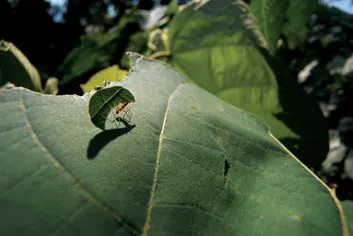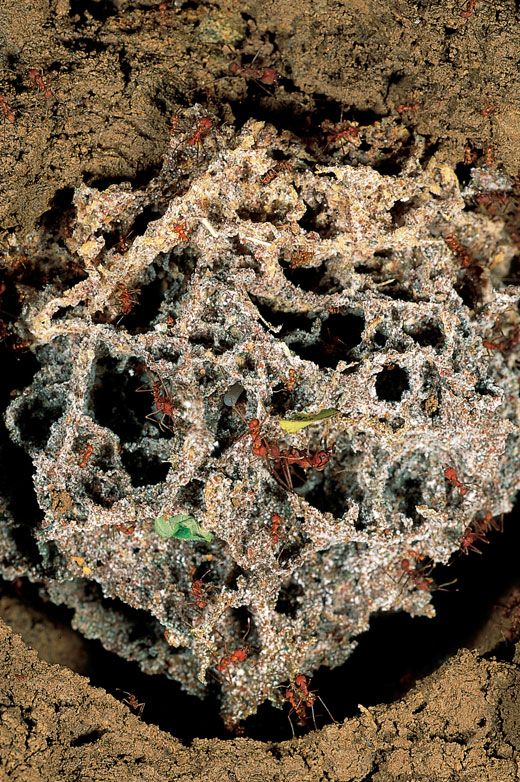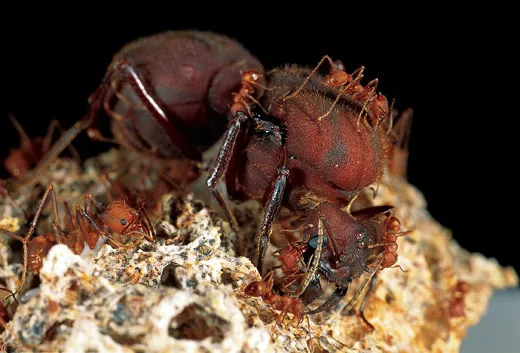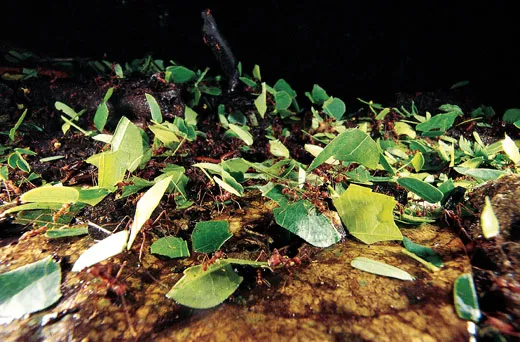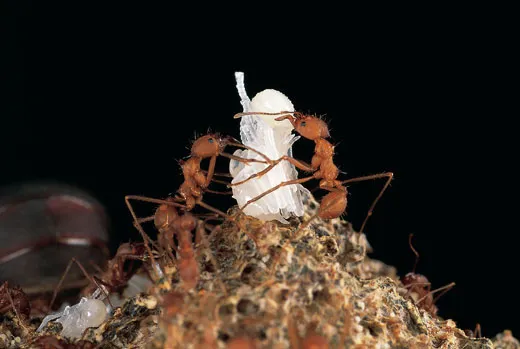Small Matters
Millions of years ago, leafcutter ants learned to grow fungi. But how? And why? And what do they have to teach us?
Beneath the rain forest canopy, a low roar from insects builds to periodic crescendos as auburn- and tangerine-colored leaves bigger than dinner plates drift down from branches above. Scarlet macaws and yellow-ridged toucans issue raspy calls. Capuchin monkeys drop detritus from the trees onto four biologists who are inching their way along a stretch of Amazon rain forest, just a few hours’ drive north of Manaus, Brazil. Inside this vast tract of jungle, which runs unbroken for hundreds of miles to the Venezuelan border, they’re hunting for clues to explain an extraordinary evolutionary event.
Somewhere near this spot 50 million years ago, after the dinosaurs disappeared, certain ant species began cultivating and eating fungus. Of all animals on earth, only these particular ants, several kinds of beetles and termites—and, of course, human beings—grow their own food. Somehow, this new tribe of ants, the attines, went—in anthropomorphic terms—from being hunter-gatherers to farmers. How and why they did so remains a tantalizing mystery.
Ted Schultz, a research entomologist from the Smithsonian Institution’s National Museum of Natural History, kneels with the intensity of a supplicant at the entrance to an ant nest. He has a mop of tar-black hair and eyes that resemble large charcoal orbs behind thick lenses. The object of his interest is a nest of leafcutters, the showiest of the attine ants.
Twenty feet up a nearby trumpet tree, the ants set upon freshly sprouted leaves, mandibles open, carving out elegant half-moons. They load these cuttings, which weigh up to ten times more than they do, over their backs and head for home, streaming back down the tree in an undulating line not unlike a band of tipsy piano movers. From a little distance, the ants, wearing stylish neon-green hats, look to be dancing.
Other streams of leafcutters flow from the shadows across brittle, dying leaves, into a clearing of vermilion sandy soil around craters in the dirt. They amble past larger ants with oversize mandibles standing vigil near the nest entrance, vanishing into long, curving subterranean channels, which open up to thousands of chambers spreading down and out through rock-solid dirt.
Millions of ants in an area the size of a small bedroom fill the nests. Once inside the chambers, the leafcutters drop their burdens. Tiny gardening ants take over. They clean, trim and crimp edges of the leaves, smear their own secretions on them and rough up the surfaces. On these chunks of leaf, which they line up in neat rows, the ants then place bits of homegrown fungus.
Schultz and his close collaborator, Ulrich Mueller, a behavioral ecologist from the University of Texas at Austin, believe that the leafcutters’ ability to grow and harvest fungi is akin to human agriculture. They even suggest that humans have something to learn from the ants, pointing to the recent discovery that attines use antibiotics to keep diseases in check inside their fungus gardens. “Have you ever tried to keep anything in the tropics free of pests for more than a few seconds?” Schultz says. “This is an amazing achievement.” Perhaps, he suggests, a careful study of the ants will yield ways for humans to fight disease or to farm more sustainably. “These ants have a positive feedback system—50 million years of sustainable agriculture,” Schultz says.
This remarkable record seems particularly poignant here in the rain forest. During the drive north on the new, 1,000-mile highway running from Manaus to Caracas, the fish-bone pattern of development that despoils large swaths of the Amazon is evident, with new dirt logging roads fanning off in every direction. By contrast, “the leafcutters aren’t skewing things,” Schultz notes. “You could imagine lots of scenarios where the ant nests in these forests just get bigger and bigger, where they would carry this agriculture to the point where they would tip the whole system. But they don’t.”
Schultz and Mueller have returned to the Amazon to try to figure out how the first ant—the mother of all gardener ants—began growing her colony’s food. What did she look like? How did she behave? And how on earth did she manage such a momentous transformation?
Humans have been intrigued by leafcutter ants for centuries. The Popol Vuh, the ancient Mayan chronicle, celebrated their intelligence and communication skills. Charles Darwin, on first visiting Brazil’s tropical forest, was struck by their ubiquity and industriousness. “Well-beaten paths branch off in every direction, on which an army of neverfailing foragers may be seen,” he wrote in 1839.
A few decades later, the great English naturalist Henry Walter Bates, noting the leafcutters’ industry and grace in his 1863 masterwork, The Naturalist on the River Amazons, also recorded a more baleful view—that of local farmers who considered the ants a “terrible pest.” But Bates, like other observers, thought the leafcutters used their cuttings as protection from rain. (They are also called parasol ants.) It took an engineer and self-taught ecologist, Thomas Belt, to finally figure out how the leaves were actually used. On a mining operation in Nicaragua, Belt excavated two leafcutter nests. To his surprise, he could find few signs of cut leaves. Upon close examination of the spongy brown material filling the chambers, however, Belt noticed “minutely subdivided pieces of leaves, withered to a brown color, and overgrown and lightly connected together by a minute white fungus. . . .” The leafcutters, Belt wrote in 1874, “are, in reality, mushroom growers and eaters.”
Not long after, William Morton Wheeler, the dean of ant research at Harvard, wrote an entire book on the fungus growers. And Edward O. Wilson, who would later succeed Wheeler as the preeminent ant scholar at Harvard, dubbed leafcutters “among the most advanced of all the social insects.”
But researchers trying to better understand Belt’s breakthrough observations faced major obstacles, particularly when it came to identifying the kind of fungi the ants were growing. Scientists typically identify a fungus through its sporophore, the part of the plant that produces spores. In ant gardens, however, the sporophores are rarely in evidence for reasons that remain unclear. “It’s as if the ants have castrated the fungus,” Schultz explains. (In essence, the ants propagate the fungi by taking cuttings.) Lacking a method for identifying fungus types, scientists were missing half the story.
This is where things stood when mueller and Schultz first crossed paths at CornellUniversity in the late 1980s. There, they teamed up with fungus specialists Ignacio Chapela, now at the University of California at Berkeley, and Stephen Rehner of the U.S. Department of Agriculture in Beltsville, Maryland. Chapela pulled individual strains of fungi from the ant gardens and kept them alive. Using molecular genetics techniques, Rehner then described the differences between the various strains. Schultz matched those results with his DNA analysis of the associated ants. In 1994, the foursome published a study in Science magazine documenting the interaction between fungi and the ants. “It is now clear,” they wrote, “that the origin of the fungus-growing behavior was an extremely rare event, having occurred only once in the evolutionary history of the ants.” The most sophisticated attines, the researchers surmised, had propagated one fungus lineage for at least 23 million years.
In a follow-up report four years later, Mueller, Rehner and Schultz modified the accepted wisdom, arguing that attine fungi often represented a variety of species—not just one passed along by founding queens from nest to nest. More “primitive” attines, the scientists wrote, sometimes share their fungus with one another, even with distantly related ant species—a version, the biologists suggested, of crop rotation. “We can show that crop failure is a major issue in their lives,” Mueller explains. “They do the same thing that humans have done, going to the neighbors to find a replacement, sometimes stealing it, sometimes overrunning and killing the neighbors, too. We’ve shown this in the lab. The next logical thing is to look for it in the wild.”
The scientists’ penchant for likening ant fungiculture to human agriculture has drawn critics. Naomi Pierce, a Harvard specialist in ant/plant interactions, praises their fieldwork, but thinks that turning ants into farmers may be carrying things too far. “The trouble is that you can get trapped by the metaphor,” she says. Ants, of course, did not consciously develop agriculture. Projecting human intention onto ants, says Ignacio Chapela, may blind researchers to the reasons why ants do what they do.
While Mueller and Schultz worked on the ants’ relationship to fungi, a team of biologists at the University of Toronto were noting—and wondering about—the presence of a persistent and ravaging mold, called Escovopsis, in attine gardens. How was it, they asked, that this potent parasite didn’t regularly overrun the attine nests? Taking note of a white powder on the undersides of the attine ants, they ultimately identified it as a type of bacteria, Streptomyces, that secretes antibiotics. The antibiotics were keeping the Escovopsis at bay. More important, they were doing so over long periods of time, without the Escovopsis becoming totally resistant.
There may be a kind of “staged arms race,” says Cameron Currie, one of the Toronto researchers (now at the University of Kansas), in which the attine antibiotics continually adapt to any resistance built up in the Escovopsis. The parasite isn’t wiped out entirely, but neither does it swamp the nest. Currie is now trying to determine how long this chemical cross fire has been taking place.
A textbook case of symbiosis between the ants and fungi suddenly was shown to have four major players—or five, if you count the antibiotics produced by the bacteria. When these antibiotics don’t do the trick, the ants chop out infected chunks of fungus and drag them far from the nest.
In the rain forest, dawn has yet to break; nocturnal Blepharidatta ants, close relatives of the attines, are still at work, hauling minuscule grains of cereal, which Mueller spread around the night before. The bait has let Mueller track the Blepharidatta to their nest. Because Blepharidatta, which do not grow fungus, have been observed carrying around bits of free-living fungus, Mueller suspects they may be on the verge of cultivation themselves. Mueller is particularly intrigued by experiments in which Blepharidatta move clumps of fungus closer to their nests. “We’re looking for something very deep in the evolutionary past,” Mueller says. “Some ant in these forests started to associate with the fungus. And that transition is the same transition that human beings made.”
Mueller switches on a headlamp. “We’re trying to track things back, but we won’t find the ‘ancestor’ out here, of course,” he explains. “What we’re looking for is a species that has retained some of the traits that characterized the ancestor.” It’s not unlike how linguists visit isolated peoples to study how patterns of speech have changed, he says. “That’s something like what we’re doing here, looking at how the most primitive behavior might have yielded more elaborate behavior.” Evolution, in other words, plays out less neatly than the clear lines that you might remember from junior high school and more like a film in which sequences can repeat, remain unchanged or even run backward in a kind of counternarrative.
Mueller’s pants are streaked with sweat and mud, flaming welts dot his neck and arms, and mosquitoes buzz near his ears. “We’re a bit abnormal in our obsessions,” he admits. “We’re really on the extreme. Who else would sweat in the forest in order to find these stupid ants!”
As a child, Mueller says, he “wasn’t much interested in bugs.” Perhaps this was because his father, a botanist for the Bayer chemical company, was stricken by a mysterious tropical disease contracted on an expedition in El Salvador when Ulrich was just 4 years old. Mueller was 9 when his father died of the disease. After dropping out of medical school, he read Edward O. Wilson’s controversial book Sociobiology (an effort to link the behavior of all animals, from ants to humans, in one grand synthesis). Immediately he knew what he wanted to do with his life, to take “an evolutionary approach to understanding animal behavior, social behavior, and then human behavior.”
Schultz, too, came to ants through a circuitous route influenced by Wilson. Raised in a small, blue-collar town south of Chicago, the son of parents who did not go to college, Schultz went to a strict Lutheran school. There, one of his teachers tried to convince him that “dinosaur bones were just buried in the ground by God to test our faith.”
After dropping out of the University of Chicago and drifting west to San Francisco in the early 1970s, Schultz held a series of jobs—dental technician, water bed upholsterer, and printer—before trying his hand as a writer of critical essays about paranormal phenomena (“Blobs From Space” and “Stranger than Science”). On his way to work one morning, Schultz, then in his 30s, began reading Wilson’s The Insect Societies. Ants attracted him because they combined “aesthetic appeal” with tangibility. “I was chasing a lot of things that filled me with wonder,” Schultz recalls. “But I needed a criterion for figuring out not just those things that appear to be filled with wonder, but those things that appear to be filled with wonder and are real.”
Although thousands of ants from dozens of species are on the move through thick leaf litter, Schultz is fixated on a particular, solitary ant, which has clipped a piece of wild mushroom and is hauling the booty across a log, wobbling under its load. “Hey, you have to see this!” Schultz shouts to Mueller. It’s a Trachymyrmex, among the more derived, or “higher,” attines.
Schultz is excited. And surprised. Though he has read about attines carrying wild fungi into their nests, he’s never seen one actually do it. And why would they? The introduction of an incompatible fungus might well disrupt, or even destroy, the entire ant garden. What’s going on here?
“This is a puzzle,” Schultz says. “I would expect the ants to be very choosy about what they bring into the nest, to have some kind of sensory bias that accepts the ‘good’ fungi and rejects all the ‘bad’ ones.” Mueller notes that many plants use ants to disperse seeds, though whether the ants exercise choice about what they pick up, or only respond to the seduction of plant secretions, remains unclear.
Schultz is looking positively giddy, even though the ant and its fungus could turn upside down many of the things he and his colleagues have written, not to mention challenge most of their assumptions. “Maybe it’s not that the ant found the fungus,” Mueller suggests with a wry smile. “Maybe it’s that the fungus found the ant.”
Both Schultz and Mueller credit their fungi-obsessed collaborators for leading them to the idea that the fungi are profiting as much from the relationship with the ants as the ants are from the fungi. Carried by the ants, protected by them and tended in gigantic gardens, the fungal clones enjoy reproductive capacities far beyond what they could achieve untended. After all, free-living fungi often exist on just a tiny swatch of leaf litter, reproducing only once or twice before dying out. Inside the nests, the fungus becomes, in Stephen Rehner’s view, “immortal in comparison to any of their wild relatives.”
Possibly the fungi developed tricks to fool the ants into moving and harvesting them. Secretions on the surface of the fungi could function like mind-altering drugs, bending the ants to the fungi’s service. “I think the other fungi are constantly trying to break the chemical codes that help ants recognize their garden fungi, saying: ‘Hey, I taste and smell right! You can’t resist me. Pick me up and take me home,’” Schultz speculates. “Do not underestimate the power of the fungus,” Mueller intones.
Indeed, the very next afternoon, Schultz returns from an outing with impressive evidence of that power. He had come upon a gigantic black ant known locally as a bala—fierce, with a potent sting—clamped around the top of a shrub’s branch. It was rigid and dead. From the back of the ant’s head, a brown sporophore gruesomely protruded, as if in an insect version of the movie Alien. The fungus had infected the ant’s body, growing inside and consuming it. Then, through some kind of yet-to-be-discovered catalyst, the fungus had apparently urged the ant to climb to the top of a branch, where its spores could be spread to maximum advantage. There, a sporophore sprouted through the ant’s head and released its spores.
Back up the trail and in the forest, Schultz ambles, his shirt and pants pockets crammed with vials filled with alcohol. He stops beside a log, kicking off its bark. Out tumble half a dozen Acromyrmex, leafcutters that often build their nests in logs. Below the alarmed insects a riot of brown and tan fungus blooms. “You’d be amazed at how many fungus gardens are out in the forest,” Schultz says. “They’re everywhere.”
Across the hillock, kneeling in the dirt, he spies a tiny dust-colored creature with a wobbling, oversize head. It’s a Cyphomyrmex, among the least studied of the attines. Schultz leans over this creature, no larger than a comma, and observes it carefully.
Fieldwork in the Amazon is far messier than genetic analysis of ant corpses in the comfort of Schultz’s air-conditioned lab back in Washington, D.C. But this is the only way “to experience real, unfiltered biology,” he says. “It’s that complexity that is almost guaranteed to reward you with something you didn’t expect.” Perhaps the Cyphomyrmex will give up one small piece of the puzzle that Schultz and Mueller have dedicated their careers to putting together. In tackling some of the biggest questions in the cosmos, Schultz says as he studies the ant’s meandering gait, it’s best to “think small. That’s what’s great about being out here. Thinking small opens up all kinds of possibilities.”
